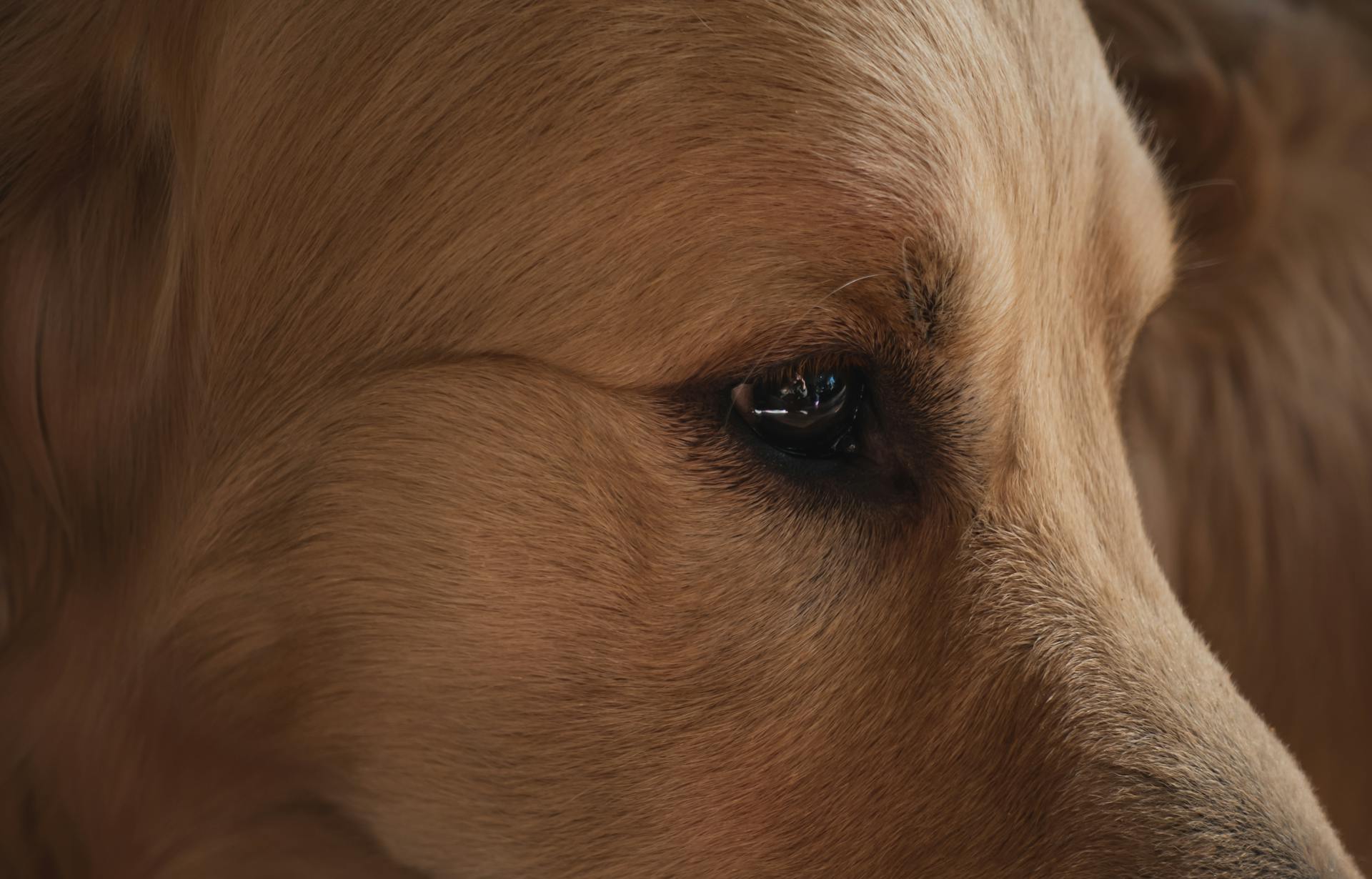
Dogs have a unique visual system that's different from ours. Their eyes are positioned on the sides of their head, giving them a wider field of vision.
This means dogs can see almost 270 degrees around them, compared to our 180 degrees. That's why they're often better at detecting movement and changes in their surroundings.
Dogs also have a reflective layer in the back of their eyes called the tapetum lucidum, which helps them see better in low light conditions. It's like having a built-in flashlight in their eyes!
As a result, dogs are more sensitive to movement and can see better in the dark than humans.
Key Takeaways
Dogs have a unique visual system that's different from ours. Their color vision is described as dichromatic, or "two-colored".
This means dogs can see the world in shades of blues and yellows, but struggle with red and green. It's similar to how humans with red-green color blindness see the world.
Dogs are actually pretty good at distinguishing between variations of blues and yellows, which is helpful for them in their daily lives.
Here's a comparison of dog color vision and human color vision:
Despite the differences, dogs are incredibly skilled at navigating their surroundings and detecting movement. It's not surprising, given their unique visual abilities.
Color Vision
Dogs have only two types of cone photoreceptor cells, which almost identically correspond to short-wave and long-wave sensitivities, allowing them to distinguish blue from yellow but not red from green.
Their eyes are structured similarly to those of people with red-green color blindness, who also lack the third kind of cone normally present in humans.
Dogs' brains interpret signals from their cone cells much like the brains of people with colorblindness do, which means they see shades of gray where we see red or green.
A dog's brain interprets the excitation or suppression of neurons in the retina as the sensation of yellow or blue, but has no signal to interpret red or green light.
Worth a look: Black Lab vs Yellow Lab vs Chocolate Lab
Dogs may use other cues to distinguish between red and green, and their brains might assign colors differently than ours.
There is some evidence that dogs may be able to see colors humans cannot, as their lenses transmit significant amounts of ultraviolet light, whereas these wavelengths are blocked by human lenses.
What Colors Do They See?
Dogs have two types of cone photoreceptor cells, which almost identically correspond to short-wave and long-wave sensitivities.
They can perceive blues and yellows quite well, but red and green may appear as browns and grayscale to a dog. This is because dogs have a yellow-blue dichromatic vision, similar to red-green color-blind people.
Dogs can distinguish between variations of blues and yellows, and they can even perceive ultraviolet light. Their lenses transmit significant amounts of UV rays, making them sensitive to UV light.
In a two-choice discrimination task, two Shiba dogs were able to identify a positive stimulus (red, blue, or green compared to grey) even though they have limited color vision.
What Colors Can Humans See?
Humans can see a wide range of colors thanks to three kinds of color-detecting cells called cones in our eyes. Our brains distinguish red wavelengths from green wavelengths and blue wavelengths from yellow wavelengths by comparing how each of these cones is stimulated by incoming visible light.
These cones allow us to see a vast spectrum of colors, from the deep blues of a clear summer sky to the vibrant greens of a lush forest. But did you know that people with red-green color blindness, whose eyes lack the third kind of cone, have a similar limitation in their color vision?
Their brains interpret signals from their cone cells much like our brains do, but with a crucial difference: they can't distinguish red from green. This means they see shades of gray where we see red or green.
In fact, our brains are so good at distinguishing colors that we can even tell the difference between subtle variations in hue, like the difference between a ripe tomato and a slightly overripe one. But for people with color blindness, these colors may appear more similar or even indistinguishable.
Broaden your view: Dogs like Bernese Mountain Dog
Dog vs Human Vision
Dogs have a unique vision compared to humans, with some notable differences. They can't differentiate as well between differences in brightness, making the world appear a bit muted and fuzzy to them.
Their vision is superior in detecting motion, and they can see more clearly in dim light. Shades of gray predominate in low-light conditions, and having good color vision doesn't offer much of a benefit.
Dogs have a remarkable sense of smell, with studies indicating it's 1,000 to 10,000 times better than ours. This keen sense of smell helps them navigate the world.
Their powerful nose makes up for the fact their other senses, like sight, might not be as stellar.
Intriguing read: Dog Smell
Sensitivity and Perception
Dogs have a unique way of perceiving the world, and it's different from humans. Their visual system is adapted to their environment and lifestyle.
Visual perception in dogs is influenced by their brain's interpretation of physical properties of an object. This means that their perception may not always accurately reflect the physical properties themselves.
Research has shown that dogs have a dichromatic visual system, which is different from humans who have trichromatic vision. This means that dogs see the world in shades of yellow and blue, but not in red.
Dogs' visual perception is also affected by their brain's ability to adapt information based on experience and neurological connections. This allows them to navigate their surroundings in a more "adaptive" way.
Bayesian explanations for visual perception suggest that the brain creates an optimal combination of incoming sensory information and prior knowledge to make sense of an environment. This is how dogs and other animals perceive the world.
In a study by Pongrácz et al. (2017), researchers altered images to simulate dog visual perceptive conditions, creating a blurry and less colorful scene. Humans who viewed these altered images performed poorly at distinguishing certain contextual information, highlighting the differences in human and dog visual perception.
Suggestion: Can a Dog Flea Live on Humans
Brightness Discrimination
Brightness Discrimination is a complex aspect of canine visual perception.
Two studies have reported conflicting results on dogs' sensitivity to differences in brightness. Stone (1921) observed relatively low brightness discrimination thresholds for two fox terriers.
In fact, the thresholds were comparable to those observed in humans, with Weber fractions of 0.12 and 0.10.
However, this study had a potential limitation, as it only assessed the dogs on one standard brightness intensity. This is in contrast to psychophysical studies on humans, which have shown that brightness discrimination thresholds decrease with increasing light intensity.
More recently, Pretterer et al. (2004) observed that brightness discrimination was about two times worse in dogs than it is in humans.
The reported Weber fractions of 0.22 and 0.27 for three subjects, a German Shepherd and two Belgian Shepherds, suggest a relatively high brightness discrimination threshold for dogs.
It's worth noting that the high threshold observed by Pretterer et al. (2004) may be due to the experimental methods used. The dogs were required to discriminate between stimuli of various intensities that were 1.1 m apart, a reasonably large distance that may have affected their choices.
Readers also liked: Dog Flea Bites Pictures on Humans
Sensitivity to Monitors

Dogs are highly sensitive to flickering lights, which can affect their perception of videos and static images on monitors.
The flicker fusion rate is the point at which rapidly flickering light appears to meld into a constantly illuminated light, and it's an important consideration when presenting videos in cognition tests.
Originally, studies suggested that dogs could detect flickering up to 20 Hz, but more recent studies have found that they can detect it up to 80 Hz, which is potentially a major problem for dog cognition studies.
Dogs' greater sensitivity to flicker-fusion rates may also affect their perception of refresh rates on monitors, which can be a concern when using CRT monitors set to present at 60-70 Hz for humans.
LCD monitors, on the other hand, typically exhibit no refresh rate-induced flicker and are commonly set to present at 60 Hz, which is a safer option for dog cognition studies.
On a similar theme: When You Lie down with Dogs?

The physiological differences between dogs and humans in terms of flicker sensitivity are significant, and researchers need to be aware of these differences to ensure accurate experimental outcomes.
Studying flicker fusion rates in dogs offers valuable insights into their functional qualities of visuoperception, and researchers should utilize proper technological tools to accommodate their unique sensitivity to flicker.
Depth Perception
Depth perception is a remarkable ability that allows us to perceive the world in three dimensions. In humans, this is enhanced in regions where both eyes have overlapping fields of view, which is roughly 140° due to our forward-facing eyes.
Dogs, on the other hand, have a much narrower binocular overlap, estimated to be around 30-60° in behavioral studies. However, this can vary depending on the breed and methodology used to calculate the estimates.
The visual cliff experiment showed that young puppies have outstanding monocular and binocular depth perception. This suggests that adult dogs may have even better visual depth perception, although more research is needed to confirm this.
Interestingly, dogs lack alpha ganglion cells in the peripheral binocular overlap, which may impair their depth perception in certain areas. This highlights the importance of further research to determine the extent of depth perception in dogs and how it varies by breed.
Perception and Misperception
Our brains process visual stimuli to interpret the world around us, but this interpretation isn't always accurate. Visual perception reflects the brain's interpretation of an object's physical properties, but may not always match the actual properties themselves.
The brain adapts information based on preconceptions and neurological connections, allowing us to navigate the world in a more adaptive way. This is especially evident in how our brains process visual information, which is influenced by prior knowledge and sensory information.
Research on Bayesian explanations for visual perception suggests that the brain creates an optimal combination of incoming sensory information and prior knowledge to make sense of our surroundings. This is a complex process that involves multiple physiological and neurological components.
The way we perceive the world is different from how other species perceive it. For example, dogs have a different visual system than humans, which affects how they process and utilize visual information.
Frequently Asked Questions
Is a dogs vision clear or blurry?
Dogs have limited visual acuity and may perceive the world as slightly blurry, making it difficult for them to focus on distant objects. Their vision is not as clear as humans, but it's still remarkable in its own way.
How do dogs see an example?
Dogs see the world in shades of blue and yellow, perceiving colors like grass as a combination of these two hues rather than green. This unique visual perspective is a result of their dichromatic vision.
What does a dog's vision look like?
Dogs have dichromatic vision, seeing the world in shades of yellow, blue, and gray, but not red, orange, or green. Their unique visual perspective is a result of their adapted color spectrum.
Sources
- https://www.petmd.com/dog/general-health/what-colors-can-dogs-see
- https://link.springer.com/article/10.3758/s13423-017-1404-7
- https://www.livescience.com/34029-dog-color-vision.html
- https://www.scientificamerican.com/article/what-colors-do-dogs-see/
- https://www.akc.org/expert-advice/health/what-do-dogs-see/
Featured Images: pexels.com

